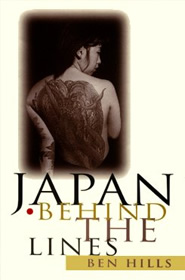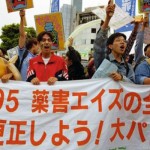Between 1993 and 1996, when Ben was based there as correspondent for the Fairfax papers the Sydney Morning Herald and The Age, the government changed three times, a terrible earthquake devastated the city of Kobe, killing 6000, a doomsday cult attacked the Tokyo subways with sarin gas, and the country commemorated the 50th anniversaries of the atomic bombing of Hiroshima and Nagasaki and the end of World War II.
Ben was an eye-witness to these events and reports on them in this book. But he also looks at the major social changes stirring in Japan in the 1990s as long-held attitudes and beliefs were challenged as this ancient civilisation comes to terms with its place in the modern world. The country struggled to adjust to radical changes in its identity – in the workplace, in schools and universities, in politics and the bureaucracy, in the way minorities are treated, how criminals are dealt with, even how the Japanese enjoy their leisure.
Travelling with his wife, photographer Mayu Kanamori, through most of Japan’s 47 prefectures – from the gale-swept Russian outposts of the Kurile islands to the haunted caves of tropical Okinawa – Ben writes about the way these changes impact on the lives both ordinary and extraordinary citizens. He talks to farmers and fishermen, doctors and teachers, welfare workers and the homeless, lawyers and scientists, salarimen and journalists, the gangster boss, the foundry foreman, the geisha, the kamikaze pilot, the art-dealer, the chef, the Marxist historian, the Hiroshima survivor, the Catholic cardinal, the Ainu elder, and scores of ordinary Japanese.
The book is not a heavy economic treatise, nor is it a glib account of the Japanese stereotypes that are many people’s picture of this complex culture. It is an entertaining and thoughtful insight into postwar Japan, its politics and its people, delving beneath the tattamae, the outward façade that Japan presents to the world, to find out what they really feel about their country and the challenges it faces as it enters the 21st century.
Publishing Info
Japan – Behind the Lines was published by Sceptre, a division of the Hodder Headline publishing group.
It is out of print, but may be found in public libraries or obtained from online second-hand book sites such as www.alibris.com
The 1990s were times of great social, political and geological upheaval in Japan. Clockwise from top left: Descendants of survivors of the atomic bombing of Hiroshima demand justice; relatives of people who contracted AIDS through contaminated blood transfusions demonstrate; overworked, bullied and beaten, school-students as young as 12 make suicide pacts; a sleeping salariman — there was an epidemic of karoshi, or ‘death from overwork’; a grieving survivor of the 1995 Kobe earthquake which killed 6000. Photos Mayu Kanamori.
One thought on “Japan – Behind the Lines”
One thought on “Japan – Behind the Lines”
-
Thank You For Sharing
I Support You
I Love Japan






Thank You For Sharing
I Support You
I Love Japan